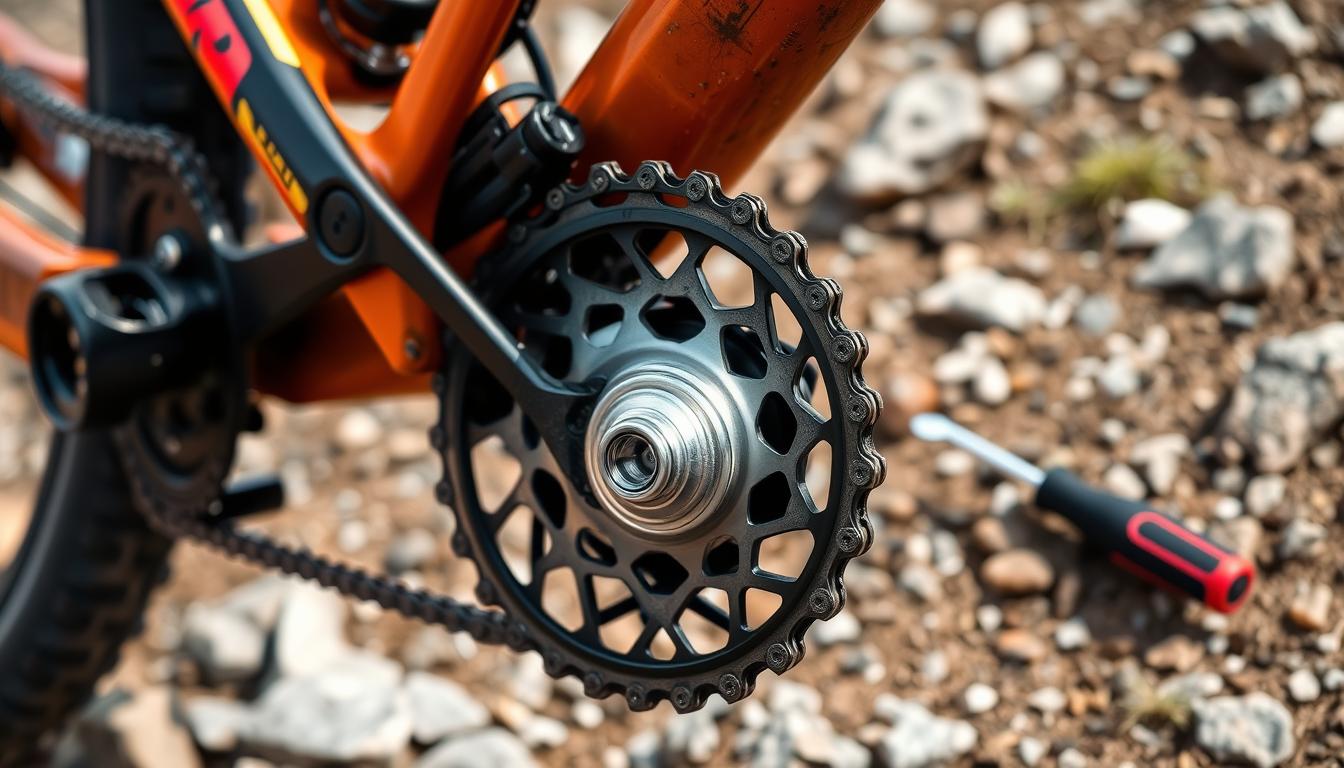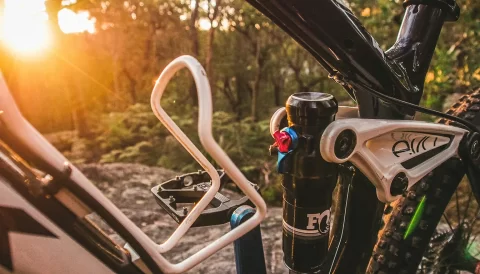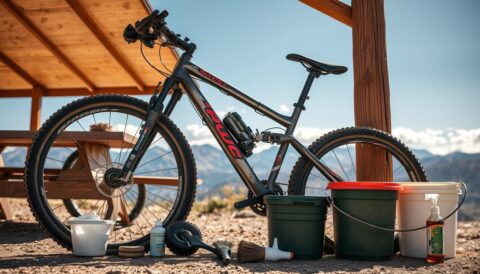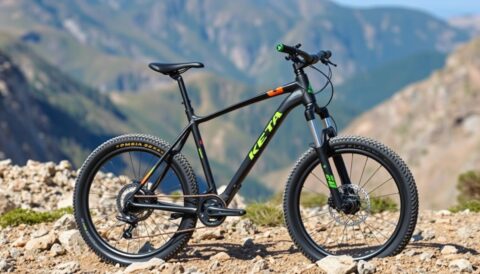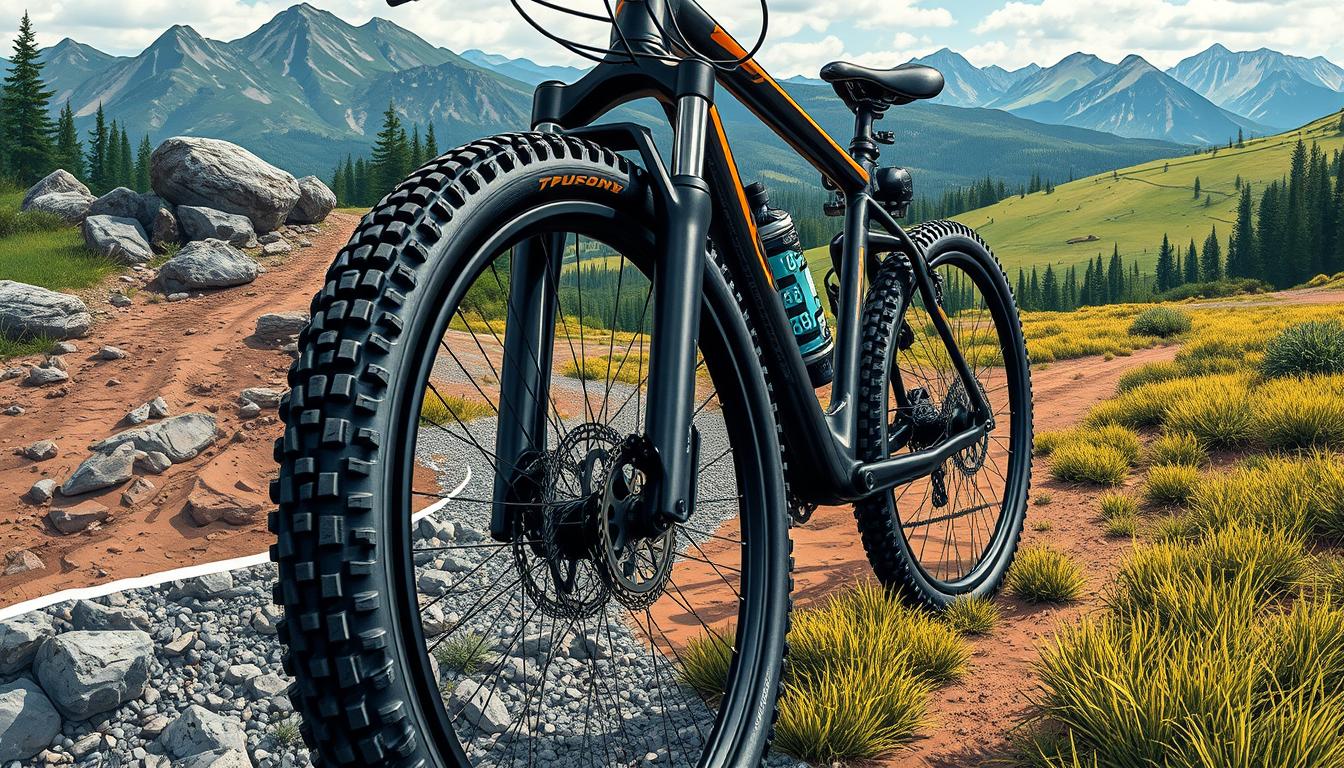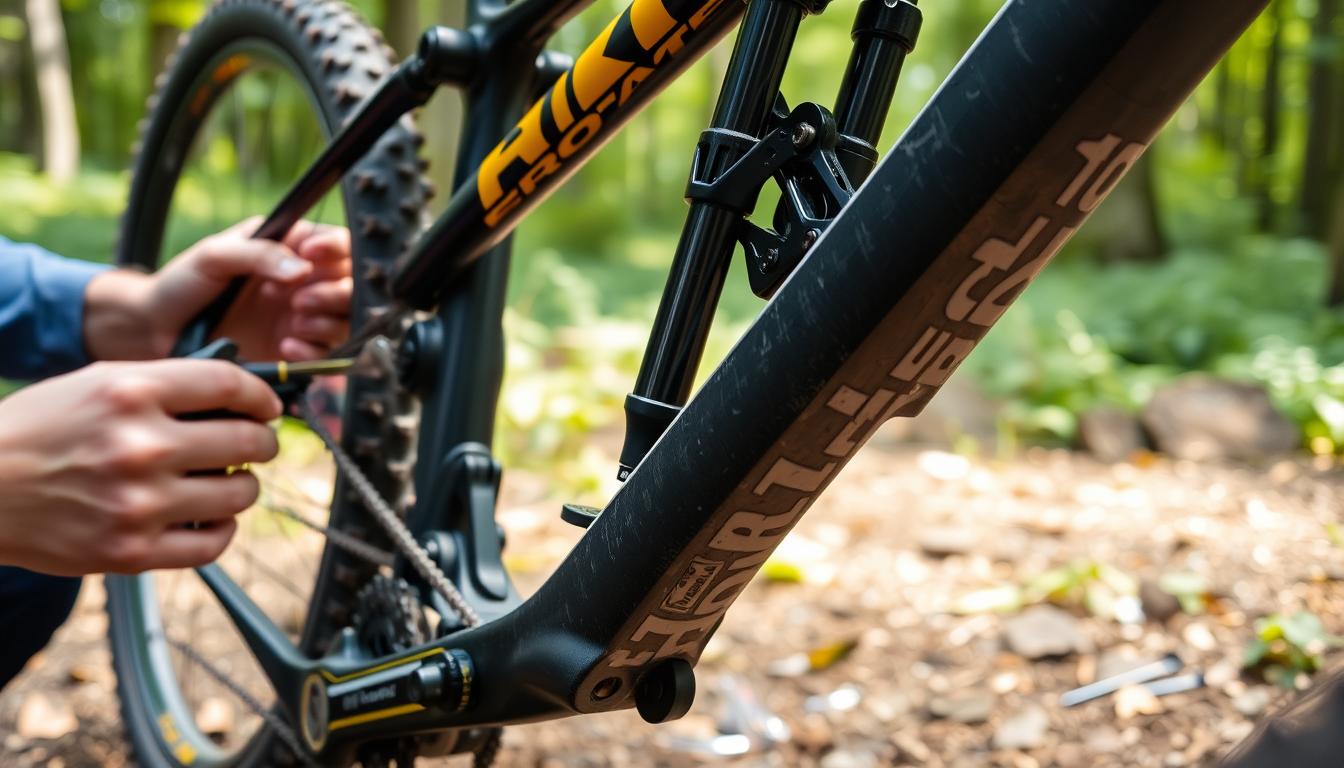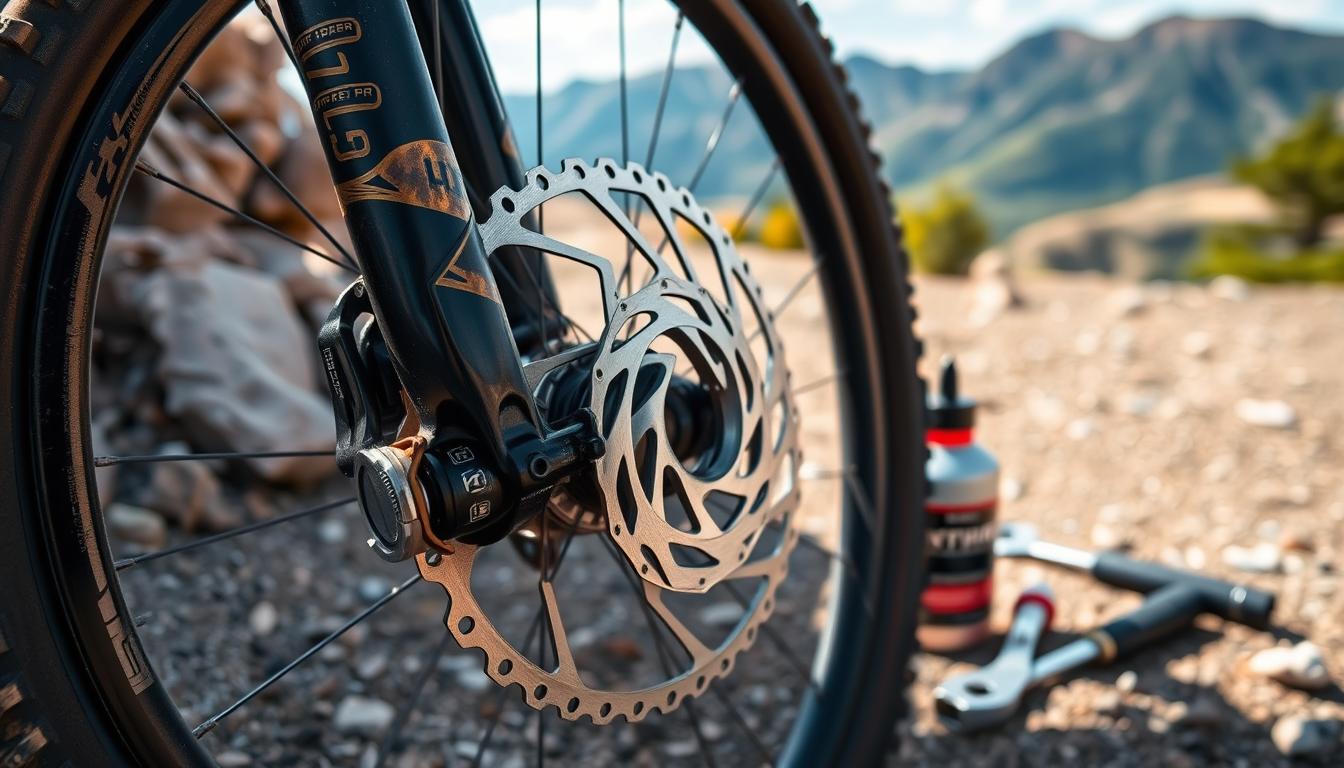Mountain bike gears are vital for your riding performance. They turn pedal power into trail-conquering momentum. Proper gear adjustment can greatly improve your cycling experience.
Modern mountain bikes often use 1x drivetrains with 12 gears. This setup offers a wide range of shifting options. Precise adjustment ensures smooth, accurate gear changes with each shifter click.
Good bike maintenance starts with understanding your gears. The shifter, cables, and derailleur work together for shifting performance. Proper adjustment can make the difference between a frustrating and seamless ride.
This guide covers essential techniques for mountain bike gear adjustment. You’ll learn how to achieve optimal shifting performance. We’ll explore understanding your drivetrain and fine-tuning cable tension.
Understanding Mountain Bike Gear Systems
Mountain bike gear systems have transformed trail riding. They’ve changed how cyclists tackle tough terrains. Modern mountain bikes mainly use a 1x drivetrain system, simplifying gear management and boosting performance.
Types of Drivetrain Systems
Cyclists can pick from several drivetrain setups. Each one offers unique benefits:
- 1x drivetrain: Single chainring with wide-range cassette
- 2x drivetrain: Two chainrings for broader gear range
- 3x drivetrain: Three chainrings for maximum gear versatility
Components of a Modern MTB Drivetrain
A typical mountain bike drivetrain has several key parts. The chainring moves power from pedals to the bike.
The derailleur guides the chain between gears. The cassette offers multiple gear options for different terrains.
How Gear Ratios Work
Gear ratios are vital for top trail performance. You calculate them by dividing chainring teeth by rear cog teeth.
This determines how well you pedal. Choosing the right gears helps maintain a steady rhythm on varied landscapes.
“Mastering your bike’s gear system transforms challenging trails into enjoyable adventures.”
How to Adjust Your Mountain Bike Gears
Mastering gear indexing and derailleur adjustment can vastly improve your mountain biking. Proper setup ensures smooth shifting across various terrains. You’ll enjoy optimal performance on your rides.
Using the Barrel Adjuster
The barrel adjuster is crucial for fine-tuning cable tension. This small component allows precise adjustments to your bike’s shifting mechanism. It’s a key tool for smooth gear changes.
- Turn the barrel adjuster in quarter-turn increments
- Clockwise tightening reduces cable slack
- Counterclockwise loosening increases cable length
Setting Derailleur Limits
Limit screws prevent the chain from falling off the cassette. They control the derailleur’s range of motion. This ensures precise gear changes and protects your bike.
- Locate the high (H) and low (L) limit screws
- Adjust with the chain on the smallest and largest cogs
- Ensure the derailleur doesn’t overshoot the cassette
“Precision in derailleur adjustment can make the difference between a smooth ride and a frustrating experience.”
Fine-tuning Shift Performance
Achieving perfect gear indexing requires patience and careful adjustment. Start by checking your bike’s overall mechanical condition. Look for any wear or damage on shift cables.
- Test each gear while turning the pedals
- Listen for any grinding or unusual noises
- Make small adjustments to cable tension
Replace shift cables yearly for best results. Always keep your bike well-lubricated. This will ensure optimal performance on every ride.
Essential Tips for Shifting Techniques
Efficient shifting is key to enjoying trail riding. Most mountain bikes have two shift paddles on the handlebars. These allow riders to navigate different terrain with ease.
Gear selection depends on your drivetrain’s operation. Mountain bikes offer various gear combinations. These help maintain optimal cadence across different trail conditions.
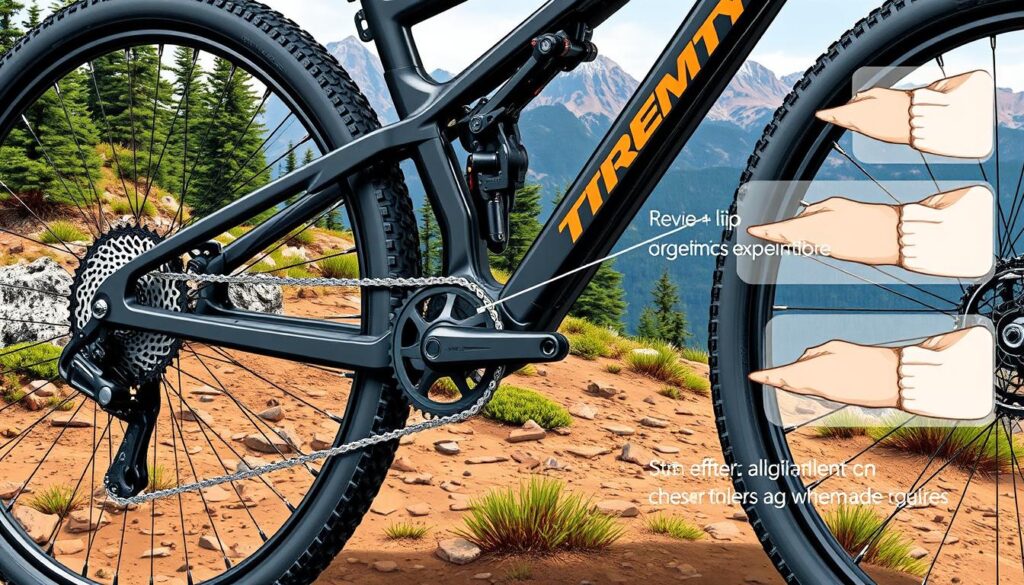
- Front derailleur shifts create larger gear changes
- Rear derailleur allows for fine-tuning gear ratios
- Aim to maintain a consistent cadence between 60-90 RPM
“The key to smooth shifting is anticipating terrain changes and selecting the right gear before you need it.”
Anticipate gear changes before steep climbs or technical sections. Shift without applying heavy pressure to the pedals. This reduces wear on your drivetrain.
Avoid cross-chaining to prevent strain on your bicycle’s chain and components.
- Shift before climbing steep sections
- Maintain a steady pedalling rhythm
- Use smaller gear increments for smoother transitions
Modern mountain bikes often use single-chainring setups. This simplifies gear selection and reduces mechanical complexity.
Practising these shifting techniques will improve your riding experience. It will also protect your bicycle’s components.
Maintaining Your Gear System
A well-maintained drivetrain is crucial for top mountain bike performance. Regular upkeep ensures smooth rides and prevents expensive repairs. Proper care of your gear system is essential for optimal cycling experiences.
Regular Cleaning and Lubrication
Effective drivetrain care begins with consistent cleaning and lubrication. After each ride, take time to clean your bike thoroughly.
- Remove dirt and debris from the chain
- Apply high-quality bicycle chain lubricant
- Wipe down derailleur components
- Check for any visible wear or damage
Recognising Wear and Replacement Indicators
Chain wear is vital to gear system health. Use a chain checker tool to monitor potential stretching.
Key signs that indicate replacement include:
- Chain stretch beyond 0.5%
- Visible rust or stiff chain links
- Inconsistent gear indexing
- Unusual noises during pedalling
Solving Common Gear Problems
Proactive maintenance prevents most gear system complications.
Cable stretch can lead to unpredictable shifting. Use barrel adjusters to fine-tune gear performance. Regular checks help spot potential issues early.
Electronic drivetrains need extra care. This includes managing batteries and updating firmware. These steps maintain optimal shifting precision.
Conclusion
Mountain biking is a journey of continuous learning and skill refinement. Effective gear adjustment offers substantial benefits for performance. It enables riders to tackle diverse terrains with confidence and precision. Understanding your drivetrain efficiency is crucial for transforming your riding experience.
Exceptional mountain bike performance requires regular maintenance and thoughtful gear management. Riders who understand their bike’s gear systems can greatly improve cycling efficiency. Mastering gear shifting techniques allows for smoother, more responsive riding across challenging trails.
Practice is key to developing intuitive gear control. Each mountain bike, from 7-speed to 12-speed systems, needs dedicated attention for optimal performance. Consistent maintenance and precise adjustments help cyclists unlock their full potential.
Gear adjustment is an ongoing process. Your mountain bike will evolve with your skills, requiring regular care. Embrace the learning curve and stay curious. Enjoy becoming a more proficient and confident mountain biker.
FAQ
How often should I adjust my mountain bike gears?
Check and adjust your mountain bike gears after every few rides. New bikes may need more frequent adjustments in the first few months. Regular maintenance ensures optimal gear performance and prevents mechanical issues.
What tools do I need to adjust my mountain bike gears?
You’ll need an Allen key set, a Phillips head screwdriver, and cable cutters. A barrel adjuster is crucial for fine-tuning cable tension. Some riders find a torque wrench helpful for precise derailleur adjustments.
Can I adjust my mountain bike gears at home?
Most gear adjustments can be done at home with basic knowledge and patience. Place your bike on a stand or turn it upside down. Start with simple tasks like barrel adjuster tuning and checking derailleur alignment.
If you’re unsure about complex adjustments, consult a professional bike mechanic.
How do I know if my mountain bike gears need adjustment?
Look out for skipping chains, difficulty shifting, and chain rubbing against the derailleur. Unusual noises when pedalling or resistance during shifting are also signs. These indicate it’s time to check your bike’s gear system.
What is gear indexing, and why is it important?
Gear indexing aligns your derailleur for smooth and accurate gear changes. It ensures each shift moves the chain exactly one cog on the cassette. Proper indexing prevents gear slipping and reduces mechanical wear.
How can I prevent gear wear on my mountain bike?
Regularly clean and lubricate your drivetrain. Avoid shifting under heavy load and maintain a consistent cadence. Replace your chain when it shows signs of stretch, typically every 2,000-3,000 miles.
Use appropriate gears for your riding conditions and avoid cross-chaining.
What’s the difference between 1x and 2x drivetrain systems?
A 1x drivetrain has a single front chainring with a wide-range rear cassette. It offers simplified shifting and reduced weight. 2x systems have two front chainrings, providing a broader gear range but with more complexity.
Modern mountain bikes mainly use 1x systems for simplicity and improved performance.
How do electronic mountain bike gear systems work?
Electronic gear systems use wireless signals to change gears instead of cables. They provide precise, instant shifting and reduced maintenance. These systems allow for custom shift patterns but require regular battery charging.
